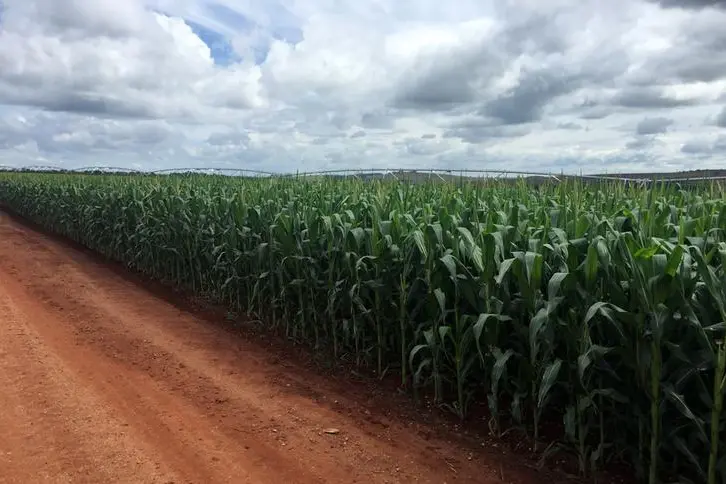PHOTO
FORT COLLINS, Colo.- Despite the efficient start for the U.S. Crop Watch producers, many of the fields have not exactly benefitted from the early planting due to cool temperatures and/or dry conditions following planting. This has led to slow and even spotty emergence in some places, but most of the growers believe those sins could be healed with some favorable weather in the near term.
This week will start warm but cooler conditions will set in mid-week and could carry through the first week of June. Close to 1 inch (25 mm) of rain is expected over the next week for most locations, but upward of 2 inches could be in store for parts of Illinois, Iowa, Nebraska and Kansas.
Crop Watch 2021 follows 11 corn and 11 soybean fields in nine major U.S. producing states each week through harvest. Three new locations were added this year, including South Dakota, western Iowa and western Illinois.
This is the fourth consecutive year for Crop Watch, and the previous three years featured eight producers and 16 fields.
The Indiana location was adjusted this year, but the other seven original growers are the same.
The average planting date for the 22 fields was April 28, seven days earlier than last year’s 16 fields. That includes Indiana’s 2020 soybean replanting date, but using the original date would still give 2021 a four-day advantage. The original 14 fields versus last year also yield a four-day spread favoring 2021.
In the super-delayed spring of 2019, the 16-field planting average was May 19, and the 2018 average was May 5.
The first 2021 fields planted were the soybeans in southeast Illinois on April 6 and Indiana on April 9. This early planting is a gamble because of possible cold May weather, but the bet appears to have paid off unlike the April 6 planted Indiana soybeans last year, which were replanted on May 26.
Nine of the Crop Watch corn fields were planted between April 19 and April 29. The North Dakota corn was planted May 7, between 10 and 17 days earlier than in the previous three years. The Ohio corn was planted on May 18, its earliest since 2018.
Western Iowa was the other early soybean planter on April 14 followed by Nebraska on April 22, but the other seven soy fields were planted in May. The final two were Ohio on May 14 and North Dakota on May 18, the latter of which was planted 15 days earlier than its prior three-year average.
POSITIVE PROSPECTS
Each week the producers will assign condition scores to their fields using a scale of 1 to 5. The ratings are similar to the U.S. Department of Agriculture’s system where 1 is very poor and 5 is excellent, but the Crop Watch condition scores do not incorporate yield assumptions. Yield ratings will come later in the season.
The crops are not far enough along in Ohio and North Dakota for condition ratings, but the other nine locations are doing relatively well. The nine-field corn average is 4.25 and for soybeans it is 4.17, which are both similar to the 2020 start and a little better than in 2018.
Southeast Illinois, South Dakota and eastern Iowa likely have the best starts, though Illinois and South Dakota could use some rain and Iowa needs warmer temperatures. The South Dakota producer notes that a truly great crop could be coming though the subsoil is the driest since 2012, so there is not a lot of room for error.
Western Iowa needs rain as does Ohio, and the Ohio producer says some replanting will occur for earlier-sown fields that were too dry. The more recently planted crops in Ohio are looking great.
The Minnesota fields have gotten more than 3 inches (76 mm) within the last few days after a historically dry April and May, though the area now needs a break from the rains. About the same amount of rain fell in North Dakota over the same period, which was critically needed following chronic dryness since last year.
Drought is still a concern for east central North Dakota, though these recent rains have boosted local growers’ spirits for now. The dry conditions in North Dakota are opposite from a year ago, when persistent wet weather significantly reduced plantings across the state.
Within the last month, the fields in Kansas, western Illinois and Nebraska have received heavier rain amounts, slowing down emergence when combined with cooler temperatures. Those locations, including Indiana and eastern Iowa, could benefit from more timely rains in the near term.
Producers in Indiana, western Iowa and Minnesota reported some uneven emergence from the dryness and cool temperatures, and the lack of warmth has also held things back in eastern Iowa and western Illinois.
The following are the states and counties of the 2021 Crop Watch corn and soybean fields: Griggs, North Dakota; Kingsbury, South Dakota; Freeborn, Minnesota; Burt, Nebraska; Rice, Kansas; Audubon, Iowa; Cedar, Iowa; Warren, Illinois; Crawford, Illinois; Tippecanoe, Indiana; Fairfield, Ohio.
Photos of the 22 Crop Watch fields can be tracked on Twitter using the hashtag #CropWatch21.
Karen Braun
(Editing by Matthew Lewis) ((karen.braun@thomsonreuters.com; Reuters Messaging: karen.braun.thomsonreuters.net@reuters.com; Twitter: @kannbwx))












